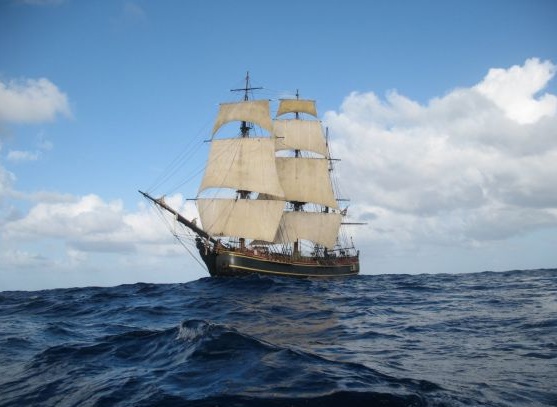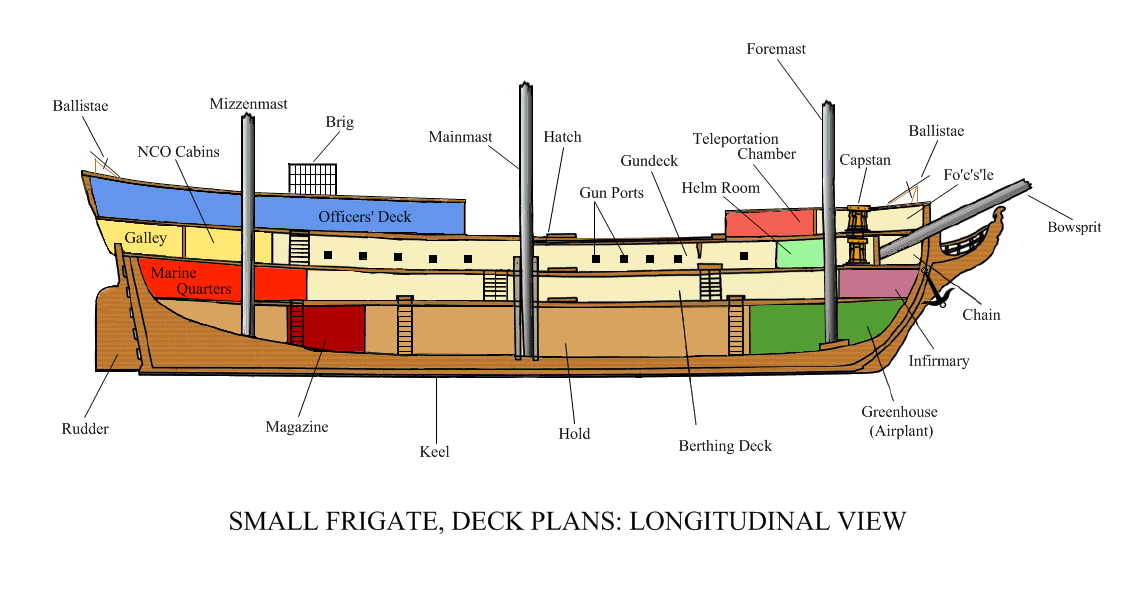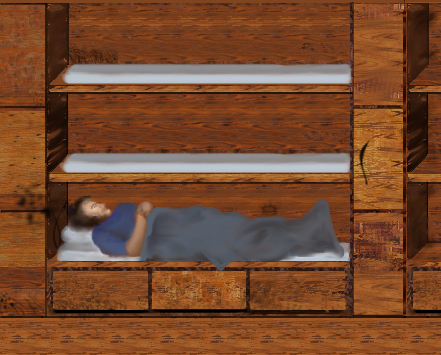Table of Contents
Ships
The chart below lists the classes of ships in the Constitutional Dominion Navy, but the tonnage per caster level applies to all ships, including merchant vessels, yachts, passenger transports, and those belonging to…shall we say, opportunists (a category that includes those individuals on the Dominion Most Wanted list).
| Ship Class | Tonnage | Caster Level (Min) | Full Crew |
|---|---|---|---|
| Greatship | 2400 | 12 | 835 |
| Flagship | 2000 | 10 | 675 |
| Large Lineship | 1600 | 8 | 515 |
| Small Lineship | 1200 | 6 | 355 |
| Large Frigate | 800 | 4 | 235 |
| Small Frigate | 600 | 3 | 175 |
| Sloop | 400 | 2 | 115 |
| Cutter | 200 | 1 | 55 |
Whatever the size, there are certain attributes common to all ships. They all must take off from, and alight into, deep, unbroken water--although with even the most skillful helmsman, bo's'n and crew, a Greatship requires no less than five miles of open ocean, while a cutter can manage with only one and one-half.
| Ship Weight (Tons) | Miles Needed For Take-off and Landing |
|---|---|
| 2400 | 5.00 |
| 2000 | 4.50 |
| 1600 | 4.00 |
| 1200 | 3.50 |
| 800 | 3.00 |
| 600 | 2.50 |
| 400 | 2.00 |
| 200 | 1.50 |
| 25 | 0.50 |
Over the past ten centuries, many attempts have been made to circumvent that requirement and permit ships to take off and alight on land, substituting wheels for sails, sweeps and rudders. Unfortunately, the helm-thrust against solid ground rebounds, instead of disseminating as it does in water, setting up large amplitude dweometric resonance that shakes the craft, causing breakage and instability, and substantially hinders, or even precludes, the smooth acceleration necessary for lift off. Increasing the sturdiness of the construction materials also increases the weight, thus demanding a higher level caster, and frequently simply provides more matter to absorb the magickal energies, increasing the plangency and worsening the problem.
As a further complication, although stretches of glassy smoothness can be achieved on land, it takes considerable expenditure of time and energy (either physical or dweometric) to make and maintain a path as smooth and resilient as the sea is innately. Additionally the need for sails and sweeps to be able to navigate once aloft remains unabated, further increasing vessel weight.
There exist a scant handful of land ships, but they are novelties: experimental prototypes, museum exhibits, or frivolous, impractical toys, owned by the very wealthy or very eccentric. The most successful ground trials to date have involved taking off and landing on ice.
CDN Small Frigate: Imirie
- The Weatherdecks are at the top of the ship and include the Quarterdeck and Fo'c's'le where the ballistae are mounted. The Brig, a metal cage where miscreants are displayed as well as incarcerated, is on the Quarterdeck.
- The Officers' Deck includes the Captain's and other officers' cabins and the wardroom.
- The Fo'c's'le houses the Teleportation Chambers and the chart room.
- The Capstan is an apparatus consisting of a vertical spool-shaped cylinder around which a chain or cable is wound; it is used to raise the anchor and to lift heavy cargo.
- The Gun Deck, of course, is where the cannons are, along with enough powder and shot for several salvoes. The Helm is located in the bow and aft are the NCO cabins and the Galley.
- The Marine non-rates bunk aft on the Berthing Deck; Navy crewmen are quartered in the waist; and the Infirmary is in the bow. This deck is also used for the storage of sails, rope and some foodstuffs.
- The Hold contains the bulk of the cargo: food, casks of water and spirits, tools, etc. The Magazine is where most of the powder and shot is stowed. The Airplant (Greenhouse) is where the life-giving plants that keep the air fresh aboard ship are grown.
Ship Specifications
| Name: | Imirie |
| Class: | Small Frigate |
| Homeport: | Arvandor |
| Status: | Active |
| Purpose: | Peacetime presence and crisis management |
| Builder: | Eldaran Boatbldg Co |
| Keel Date: | DC 9740210 |
| Launch Date: | DC 9750701 |
| Commission Date: | DC 9750721 |
| Dimensions, | Length overall: 200 ft; Length on deck: 145 ft; Beam: 32 ft; Draft: 13 ft |
| Tonnage: | 600 |
| Sail: | 14,000 sq ft |
| Rigging: | 12 mi |
| Armament: | 20 cannons, 8 ballistae |
| Hull Material: | Wood |
Shipboard Personnel
| Ship Class | Full Officer Complement | Full Crew | Helm Officers | Naval Officers | Naval Enlisted | Marine Officers | Marine Enlisted |
|---|---|---|---|---|---|---|---|
| Greatship | 48 | 835 | 6 | 29 | 427 | 13 | 360 |
| Flagship | 40 | 675 | 6 | 25 | 395 | 9 | 240 |
| Large Lineship | 32 | 515 | 6 | 22 | 363 | 4 | 120 |
| Small Lineship | 24 | 355 | 6 | 15 | 251 | 3 | 80 |
| Large Frigate | 18 | 235 | 6 | 11 | 177 | 1 | 40 |
| Small Frigate | 15 | 175 | 6 | 8 | 120 | 1 | 40 |
| Sloop | 12 | 115 | 6 | 5 | 83 | 1 | 20 |
| Cutter | 9 | 55 | 6 | 2 | 36 | 1 | 10 |
Ship Organisation and Chain of Command
The Commanding Officer (Captain) is ultimately responsible for the ship and all property and equipment pertaining thereunto (including the magickal propulsion and air quality systems), for ensuring it complies with all local and interspheral laws and pertinent Navy regulations, and for acquiring and maintaining all the certificates and documentation to prove it. He is the final overseer to make certain the vessel is speckless and spaceworthy, that cargo is properly handled, that his crew are sharp, hale and disciplined, and that the ship's inventory is current and accurate, both by value and by weight.
He is also the ship disciplinarian, having absolute authority over all embarked personnel at all times aboard ship, in the ship's launches, and on duty ashore. All personnel must follow any lawful order of the command.
The Executive Officer (First Mate) is second in command and accountable only to the Captain. He is the liaison between the Captain and the department chiefs, verifying that all areas of the ship are in readiness to carry out the ship mission and reporting any nonconformance to the Captain. In the Captain's absence or incapacitation, the First Mate assumes command.
If both the Captain and First Mate are incapacitated and unable to fulfil the duties of command, the responsibility passes down to the next most senior line officer assigned to the ship. It is worth noting that, to prevent disablement of both senior officers at the same time, by regulation their battle stations are well separated.
Below the Captain and First Mate in authority and responsibility are the department heads. Every ship is organized into at least six departments, plus the Marine complement. Although technically a member of a separate service branch, the Marine officer reports to the Captain and First Mate of the vessel as if he were a department head and is included in the Chain of Command as a line officer.
The Deck department, under the charge of the Bo's'n, is responsible for maintaining the ship's external structure and boats, interior spaces, rigging (spar, sail and cordage), anchors, cables, winches, and all the other paraphernalia that are used to keep a ship running smoothly.
The Bo's'n is in charge of all deck activities, issues the orders to the deck crews that implement the navigational instructions he gets from the Sail Master ("Hands to the halyard! Haul away!") supervises the watchstanders and assigns general work details, such as polishing the brass or swabbing the decks. He is often the Second or Third Mate, only a few steps below the Captain in seniority and authority. Given the scope and continuous nature of his duties, the Bo's'n perforce has his own mates who are left in charge of the deck crew when the bo's'n is not on duty.
The bo's'n uses a pipe to convey his orders or to make announcements of unusual or important events. The high, shrill sound can be clearly heard over other noises on a busy spelljammer, and is considered to be a badge of rank. Ordinary spacemen are not permitted to own one.
The Helm department, under the authority of the Chief Helmsman, is responsible for ship propulsion. This task is so vital that on even the smallest deep space vessel there are six Helm officers, magic users who rotate the exacting and crucial position on a schedule of four hours on, twenty hours off. However, Helmsmen are not idle between shifts. They are also responsible for the functionality and maintenance of all the magical devices appurtenant to the operation of the ship, including the Nepheligenous Sphere and the Suspiriant Aura Apparatuses (issued to all hands).
Sail, under the direction of the Sailmaster, is responsible for ship navigation, plotting the intricate trajectories that allow a ship to slip through a spheral barrier or enter a discontinuity point at the correct angle. They keep logs and records and determine the ship's position by physical and divinatory means. Additionally, the signalmen, tasked with communication between ships and with planetside ports, are attached to the Sail department.
Ordnance, under the Ordnance Master, is responsible for the ship's weapons and ammunition. The duties include ensuring the cannons and all weapons are kept in good repair, maintaining sufficient supplies of ammunition, and making recommendations on munitions selection based on current combat, sifting the powder to keep it dry and prevent it from separating, and training the ship's crew in the proper operation of all ship's weapons. A knowledgeable and capable Ordnance Master is essential to the safe and effective utilization of artillery, and also oversees the Armoury where personal weapons are stored.
Supply is run by the Purser and is responsible for all administration and supply for the ship's company, including food and drink, clothing, bedding, candles, etc., and for procuring the general stores, supplies and spare parts needed by the other departments, such as sail, cordage and ammunition, supervise the cooks, carpenters, sailmakers, and other craftsmen, and maintain all the pay records.
The Welkin is the atmosphere that surrounds and sustains the ship, so it logically follows that the Welkin department is concerned with everything that affects air supply and quality. The Welkinmaster is responsible for the care and sustentation of the ship's plants and of regulating the use of fire and other activities that would deplete or contaminate the air. Additionally, the Welkinmaster supervises the Ship's Chirurgeon, assisting as necessary in the treatment of illnesses and injuries suffered by the company, overseeing their diets to prevent nutritional diseases, purifying stagnant or spoiled food and water as needed, and controlling the spread of contagious complaints.
The Ship's Chirurgeon is responsible for the health of every soul aboard a ship, to wit, the ship's company and any auxiliaries, passengers and dependants. His duties include, but are not limited to, treating diseases, contagions, injuries, wounds in battle, and any other medical complaint that detracts from the fitness, well-being, and efficiency of those under his care. To accomplish his mission he is required to visit patients at least twice a day, while always keeping accurate records on each patient admitted to his care, take morning sick call, assisted by his mates, and posting the list of those unfit for duty on the binnacle in timely fashion.
By invariant custom, Sick Call is held on the gun deck during Minëtir (First Watch) each day, and a list excusing men from duty due to illness, or for other causes, is posted on the binnacle immediately thereafter.
In addition he must promptly tend to any member of the ship's company, and any auxiliaries, passengers and dependents, who are injured or fall ill during the course of the day, and over any and all such patients who have come or been brought under his care he has full authority concerning their state of health and fitness for duty that shall not be superseded or countermanded by any officer or minister without medical office and purview, even including the captain of the Ship. Moreover, the Chirurgeon retains his full authority despite any differences in rank between the Chirurgeon and the patient who has duly come or been brought under his care, even when, in other circumstances, the Chirurgeon would be expected to show all deference and respect to a superior officer.
Beyond carrying out his primary duty of caring for the sick and wounded, the Ship's Chirurgeon is responsible for inspecting sanitary conditions on the Ship, including quarters, galleys, mess, and heads, ensuring that they at all times remain fit and wholesome.
Although not technically speaking a department, the Marine complement functions as one in most respects. As previously mentioned, the Marine officer reports to the Captain and First Mate of the vessel as if he were a department head and is included in the Chain of Command as a line officer, and the duties of the Marines are many and varied. They are expected to serve as masters-at-arms, maintaining shipboard discipline and taking charge of prisoners, to act as honour guards for diplomatic missions, to serve as a strike force to conduct or repel boarding actions, to supplement shipboard ordnance operations, to act as the security detail for a landing party, to ensure the external security of the ship, and to perform other lawful duties as assigned.
Finally there are the common spacers, the foundation of the ship. They know sails and lines, how to turn to and square away, and, most importantly, how to follow orders.
Imirie Ship's Company
Officers
| Name | Position | Rank | Race | Planet |
|---|---|---|---|---|
| | | Kano | Elven | Arvandor |
| Nimluiiel Vanrina-Cuvanthor | | Nukano | Elven | Arvandor |
| Otto Bergschleifer | | Shaalth | Dwarven | Aendorn |
| Arphenion Dramorion | | Shaalth | Elven | Arvandor |
| Gruffydd Heddwyn | | Shaalth | Ursinoid | Gwuryll |
| Sieghard Weber | | Nushaalth | Dwarven | Fanalor |
| Laide Voronwe | | Nushaalth | Elven | Phocira |
| | | Nushaalth | Elven | Arvandor |
| Green Waters | Purser | Nushaalth | Gnomish | Stonehollow |
| Dratorshy Nyd | Helmsman | Nushaalth | Procyonid | Nexhan |
| Amonost Gondien | Helmsman | Nushaalth | Elven | Arvandor |
| Gerhold Blitzberger | Helmsman | Nushaalth | Dwarven | Aendorn |
| Thorn Winterwise | Helmsman | Nushaalth | Elven | Blackhollow |
| Jubilee Groves | Helmsman | Nushaalth | Human | Stonehollow |
| Llaursam Tok | Midshipman | Kaimelar | Procyonid | Nexhan |
Non-Commissioned Officers
| Name | Position | Rate | Race | Planet |
|---|---|---|---|---|
| Sam Holloway | Bo's'n's Mate | Angwedhu | Human | Kethlath |
| Leitha Alasse' Deasar | Chief Signalman | Angwedhu | Elven | Arvandor |
| Manfried Winkel | Purser's Mate | Angwedhu | Dwarven | Aendorn |
| Ane Tjaard | Platoon Sergeant (Marine) | Perin | Human | Farach |
| Karnil Raegbund | Welkinmaster and Chirurgeon | Perin | Elven | Yseth |
| Jelle Wubbe | Carpenter | Perin | Dwarven | Farach |
| Stebsay Nyt | Sailmaker | Perin | Procyonid | Nexhan |
| Ercwlff Glaw | Bo's'n's Second Mate | Perin | Ursinoid | Gwuryll |
| Hywel Gwythyr | Ordnance Mate | Canthui | Ursinoid | Gwuryll |
| Usk'it Swyris | Bo's'n's Third Mate | Canthui | Lizardman | Caroon |
| Kaleo Ni'kala | Chirurgeon's Mate | Canthui | Human | Arendu |
| Honen Lee | Chirurgeon's Mate | Canthui | Procyonid | Nexhan |
| Industrious Farmer | Welkin Mate | Canthui | Hobbit | Stonehollow |
| Honest Smith | Welkin Mate | Canthui | Dwarven | Stonehollow |
| Yattien Dornornoston | Sr. Section Leader (Marine) | Canthui | Elven | Phocira |
| Megildur Alagos | Jr. Section Leader (Marine) | Canthui | Elven | Arvandor |
Additionally, of the non-rated enlisted personnel, 81 of the sailors are Quanta and 29 of the Marines are Ohtar.



